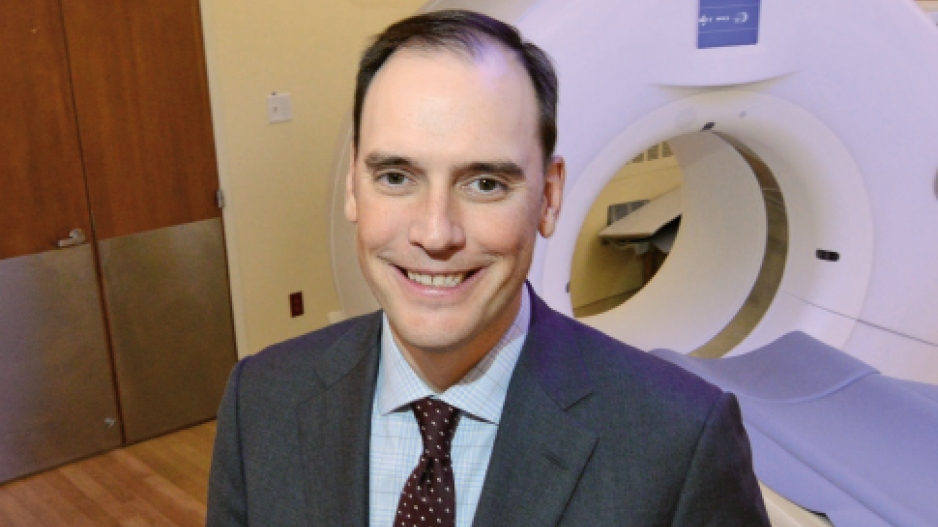At first blush, it may seem incongruous that the man responsible for a job as serious as fundraising for Royal Columbian Hospital during the largest health-care facility redevelopment in Canada once had a summer job touring southern Saskatchewan with a bike that could hold 30 riders.
But talk with Jeff Norris, president and CEO of Royal Columbian Hospital Foundation, and he’ll tell you the job was about fundraising for the Heart and Stroke Foundation – even though it may have looked as if he’d been trying to create the ultimate oversized peloton.
“When I was a university student I needed a summer job,” he said. “And I had a great time doing it.” He also raised more than twice as much as those who had gone before him, prompting the organization to offer him a full-time job and setting the wheels in motion for a career in fundraising.
Spanning two decades, Norris’ work in non-profit organizations includes stints as chief advancement officer at Kwantlen Polytechnic University (KPU), CEO of the KPU Foundation, executive director of the KPU Alumni Association, a group he was involved in founding, and seven years at St. Paul’s Hospital as director of annual and corporate giving.
One of 2013’s BIV Forty under 40 winners and recipient of the Association of Fundraising Professionals’ 2014 Giving Hearts Award, Norris is an established industry leader.
For Norris, however, those rewards pale in comparison to the potential for his work to change, even save, the lives of people such as Rose Aviado.
“If I could go to his house and thank him, I would,” said Aviado, reached by phone while on a two-day break at home from a lengthy stay in hospital.
On a morning commute that neither Aviado nor her husband, Cesar, will ever forget, what started as a mild case of acid reflux devolved within minutes into full-blown cardiac arrest. Aviado’s heart required near-constant external compressions during the ambulance journey to Royal Columbian Hospital. Emergency room doctors were then able to keep her alive with a special chest compression system that had been purchased with $20,000 in donations to Royal Columbian Hospital Foundation.
“It’s hugely rewarding,” said Norris.
In fact, Norris’ first child was the recipient of similar help. Complications during the birth were managed with the use of a machine purchased with money raised at a golf tournament. As with Rose Aviado, it made the difference between a potentially tragic outcome and a successful resolution.
“You walk away and go, ‘Wow. That’s happening every day for people at this hospital.’”
Nine times out of 10, he said, people who contribute never hear the stories of the lives they’ve changed. He tries to change that through building long-lasting connections with donors – a task both challenging and critical to continued success, he said.
“It’s all about relationships. You need to enter into those relationships with your ears open.” His approach is characterized by patience and compassion, and focuses on the giver as much as it does on the need. His values push him to understand how to meet the needs of the person or company making a donation.
“It’s going to take time and consistency,” he said, noting the importance of looking at the process from the perspectives of both the donor and the recipient. “The role of a fundraiser is really about aligning what the organization needs with what the donor wants to contribute to.”
Norris understands how to make that connection. He was a key part of the team that created St. Paul’s Lights of Hope campaign, the hospital’s primary fundraising initiative that has raised tens of millions of dollars since its inception.
He’s also savvy, and remains keenly aware of changing trends in fundraising demographics. He’s noticed that in recent years, fewer people are donating to charities.
“At the same time, we’re seeing more and more money go to charity,” he said. Average gift amounts are going up, prompting him to focus on finding new ways to engage different demographics.
Norris finds that those who do contribute are doing so with greater scrutiny of how the money is being used.
“They have a high expectation of professionalism; they expect their gifts to be dealt with in a businesslike manner,” he said. So he pushes hard to strike a balance between cost-cutting, accountability and avoiding inhibitive bureaucracy.
But what resonates most about Norris’ success is the humility with which he views it. For one with the responsibility of fundraising for one of the busiest hospitals in B.C., he views his position not as a prerogative but as an endowment.
“It’s a massive privilege to be able to do this kind of work. You get to meet people at the height of humanity, when they’re giving, when they’re at their best, and being around that every day, it’s a gift.” •




